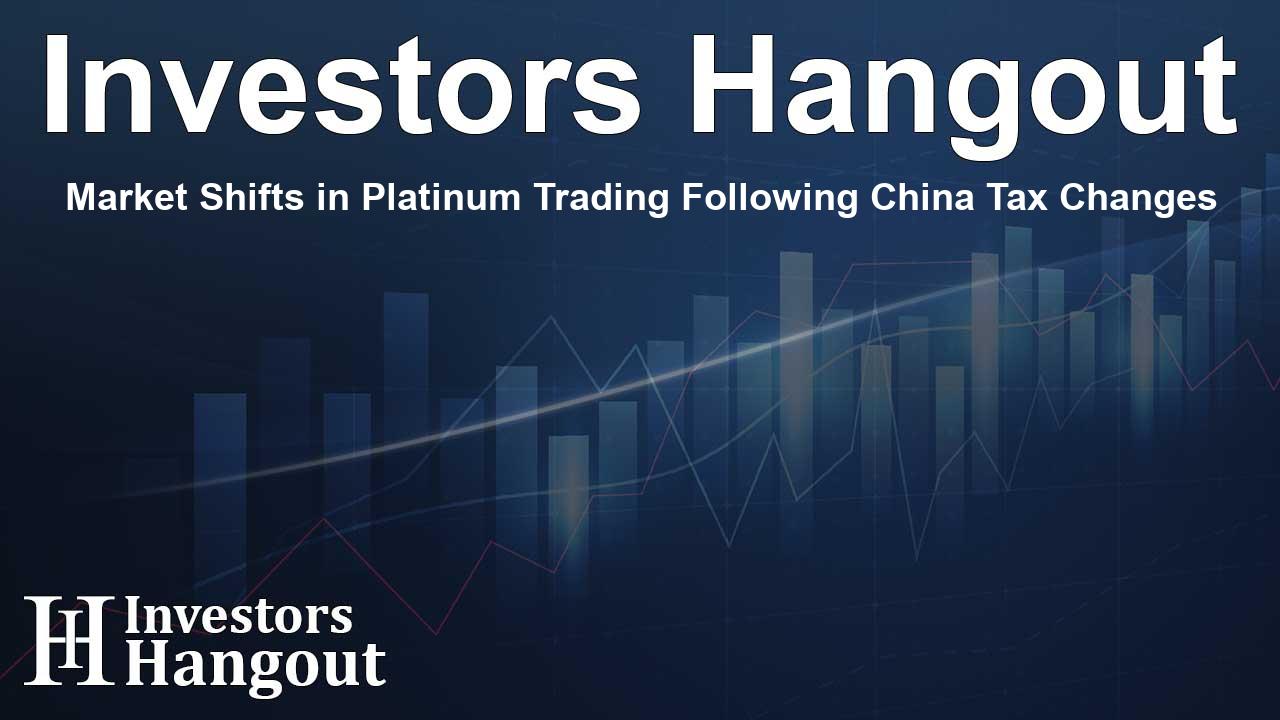Market Shifts in Platinum Trading Following China Tax Changes

Platinum Prices Surge Amid Market Volatility
Platinum has recently emerged as a hot topic in the precious metals market, showcasing remarkable volatility. Just when the market was still adjusting to the earlier dips in gold and silver prices, platinum made a significant move by rising 6.4%, reaching $1,646 per ounce in the spot market. This surge marks the most substantial intraday increase for platinum since 2020, signaling considerable shifts in investor sentiment.
Futures and Physical Market Discrepancies
While futures prices also increased by 4.1%, a rare gap between physical and paper markets appeared. Notably, the London spot premium over Nymex futures expanded to over $53 per ounce, nearly double the previous day's amount. Typically, these two markets operate in tandem, so this divergence indicates a heightened demand for physical platinum, prompting investors to act swiftly.
The Chinese Tax Policy Shift
This dramatic surge occurred shortly after significant changes in taxation policy by Chinese authorities. China, being the largest consumer of platinum, announced a phase-out of a two-decade-old value-added tax refund starting November 1. This news reverberated through global markets, as it alters the competitive landscape within the platinum sector.
The Impact of VAT Changes
Prior to this announcement, China Platinum Co. enjoyed a significant competitive edge, being the sole importer of platinum exempt from the 13% VAT. The removal of this exemption is seen as a pivotal moment for China's platinum market, highlighting the previously uneven playing field that favored this state-run firm.
Reactions from Market Experts
Weibin Deng, the Asia-Pacific head at the World Platinum Investment Council (WPIC), expressed that the dissolution of the tax exemption is a major shift for the platinum market in China, potentially leveling the playing field for other competitors who have long faced disadvantages due to this policy.
Experts anticipate that removing the rebate will amplify premiums in Shanghai over global prices, potentially encouraging buyers to procure platinum ahead of the policy's implementation, thus tightening global market conditions even further.
Current Supply Conditions and Market Performance
The existing supply constraints in the platinum market are not a new phenomenon. In 2025, platinum has surfaced as one of the hottest commodities, driven largely by increased investment and jewelry purchasing in China. Simultaneously, banks in London are facing challenges due to dwindling inventories, adding to the growing competition for available supply.
The Supply Chain Struggles
The primary challenge facing the platinum market is the concentrated and declining supply of mined platinum. South Africa dominates production, contributing almost 90% of the output in 2024. The Bushveld Igneous Complex, which accounts for about 75% of the world's known platinum reserves, underscores the significant reliance on a single geographic source.
Future Demand Projections
WPIC chief Trevor Raymond has warned about the structural deficit in the platinum market, fueled by robust demand growth particularly in China. The expected continuation of high demand patterns in the jewelry sector and investment products may not necessarily translate into increased supply. Even with higher prices intended to stimulate production, platinum inventories have not shown significant recovery. WPIC forecasts suggest that demand will consistently outpace supply throughout this decade.
Moreover, platinum's role as a critical component in hydrogen technologies and laboratory settings further emphasizes its importance in future market shifts.
Investment Insights
For investors, it's worth noting the performance of the abrdn Physical Platinum Shares ETF (NYSE:PPLT), which has witnessed a remarkable increase of 78.33% year-to-date, signaling the growing investor interest in this precious metal.
Frequently Asked Questions
What caused the recent increase in platinum prices?
The surge in platinum prices was significantly influenced by China's announcement to phase out an existing VAT rebate on platinum imports, disrupting market dynamics.
How has the VAT change affected Chinese companies?
The removal of the VAT rebate is expected to provide a more competitive environment for various companies in China, previously hampered by the competitive advantage of the sole importer, China Platinum Co.
What are the implications of the platinum supply levels?
Supply levels remain a concern, as almost 90% of platinum production comes from South Africa. This reliance on a single region poses risks for market stability.
What is the outlook for platinum demand in the coming years?
Market analysts suggest that platinum demand will continue to outstrip supply throughout the decade, driven by strong growth in jewelry and investment sectors.
How has PPLT performed in the market?
The abrdn Physical Platinum Shares ETF (NYSE:PPLT) has gained significant traction, reflecting a 78.33% uptick year-to-date, indicating robust investor confidence in platinum.
About The Author
Contact Owen Jenkins privately here. Or send an email with ATTN: Owen Jenkins as the subject to contact@investorshangout.com.
About Investors Hangout
Investors Hangout is a leading online stock forum for financial discussion and learning, offering a wide range of free tools and resources. It draws in traders of all levels, who exchange market knowledge, investigate trading tactics, and keep an eye on industry developments in real time. Featuring financial articles, stock message boards, quotes, charts, company profiles, and live news updates. Through cooperative learning and a wealth of informational resources, it helps users from novices creating their first portfolios to experts honing their techniques. Join Investors Hangout today: https://investorshangout.com/
The content of this article is based on factual, publicly available information and does not represent legal, financial, or investment advice. Investors Hangout does not offer financial advice, and the author is not a licensed financial advisor. Consult a qualified advisor before making any financial or investment decisions based on this article. This article should not be considered advice to purchase, sell, or hold any securities or other investments. If any of the material provided here is inaccurate, please contact us for corrections.
